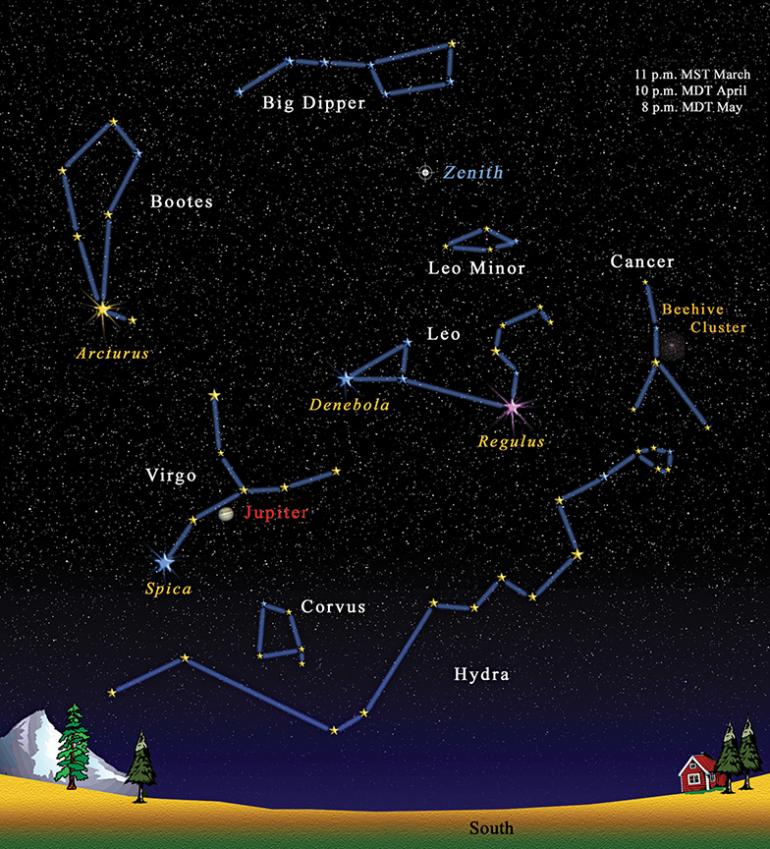Range Boss of the Sky
Tracking Jupiter this spring.
Every range needs its boss to keep the cowboys on point and the cattle moving, and the range of the sky is no different. Look southward this spring on a pleasant, clear night and you’ll find the bright light that serves as the range boss of the sky.
It will be easy to find: look generally southward after dark for the brightest “star” you can see, lying along the stem of a fainter Y-shape of stars. The Y forms the main part of the constellation of Virgo the virgin. And the bright “star” is not a star at all, but Jupiter, king of the planets and—among many ancients—the king of the sky.
Jupiter is the third-brightest object in the night sky after the moon and the planet Venus (which rises before the sun as a “morning star” this spring). Its stately orbit around the sun takes 12 years, so it moves through one zodiacal constellation, more or less, per year. Its apparently regal characteristics made it a celestial representative of the primary god of some cultures (except, perhaps, when cultures gave that honor to the life-giving sun). The Babylonians, for example, often associated it with their chief god Marduk, and the Romans, of course, with Jupiter, the king of their divine pantheon, whose Greek counterpart was Zeus.
Jupiter, or Zeus, was the king of the gods, ruler and judge of gods and men, in charge of the sky and all of its phenomena. His symbol was the thunderbolt and his favorite bird was the eagle. He came by the job forcefully, having overthrown his father, the Titan Kronos (who had earlier overthrown his father, Uranus, or Heaven). And with suitable divine prospects being somewhat limited at the time, he ultimately married his sister Juno—the Greek Hera and officially his third wife—who became queen of the gods, patron of marriage and childbirth.
The marriage bit ended up being rather ironic given that Zeus was famously known for his roving eye, and much of Greek mythology recounts his dalliances with women both mortal and divine and the adventures of his subsequent children. (Many of his paramours and offspring are further immortalized in the names of the planet’s many moons.) The Greeks also made Hera jealous of Zeus’s affairs, and some of the rest of Greek mythology recounts the vengeance of Hera upon her husband’s illegitimate children—Heracles (or Hercules) being the poster boy for this.
When he wasn’t engaging in such extracurricular activities, Zeus was said to be the author of storms and tempests and the nourishing rains, the regulator of the seasons, the font of kingly power and witness to the sacred oaths upon which government was based, the paternal overseer of humans, and the punisher of misdeeds. A full schedule, certainly. All the while, his heavenly symbol, the bright planet in the sky, rolled through the constellations, many of them related to his own history.
Consider Virgo, which the planet is visiting this year. In Greek myth, this star pattern is often associated with Persephone, Zeus’s daughter by Ceres, goddess of agriculture. The hapless girl was kidnapped by Zeus’s brother Hades, king of the underworld, to become his queen. Zeus negotiated for her release, but since Persephone had snacked on pomegranate seeds while in the keeping of Hades, she had to remain half the year with her husband. When Virgo is seen in the evening sky, it’s spring and summer; Persephone returns to her mother Ceres whose happiness makes the Earth bloom. When Virgo departs the evening sky, Persephone returns to the underworld, Ceres sulks, and fall and winter chill the land.
Virgo is also said to represent Dike, goddess of justice and Zeus’s daughter by his second wife Themis; she is the “blind justice” who still symbolizes the nation’s courts. Legend has her living on Earth during the Golden and Silver Ages of Man, but she left for the sky at the start of the Bronze Age, disillusioned when men grew coarse and greedy and warlike. Since we haven’t learned to behave better yet, there she still sits, alongside her scales of justice—the constellation Libra just to Virgo’s east.
These days, his wife has returned to Jupiter to pester him in the form of the spacecraft Juno, which presently circles the planet to study its magnetic and gravity fields, its atmosphere and its water content, for us to better understand how giant planets form in our solar system and others.
It brings us full circle back to origins and bosses, with Jupiter the boss of both the ancient gods and the circling planets of the sun, shining this year among the twinkling stars of spring.
Jim Manning, formerly the executive director of the Astronomical Society of the Pacific in San Francisco, lived outside Bozeman for many years and has returned to live here once again.












